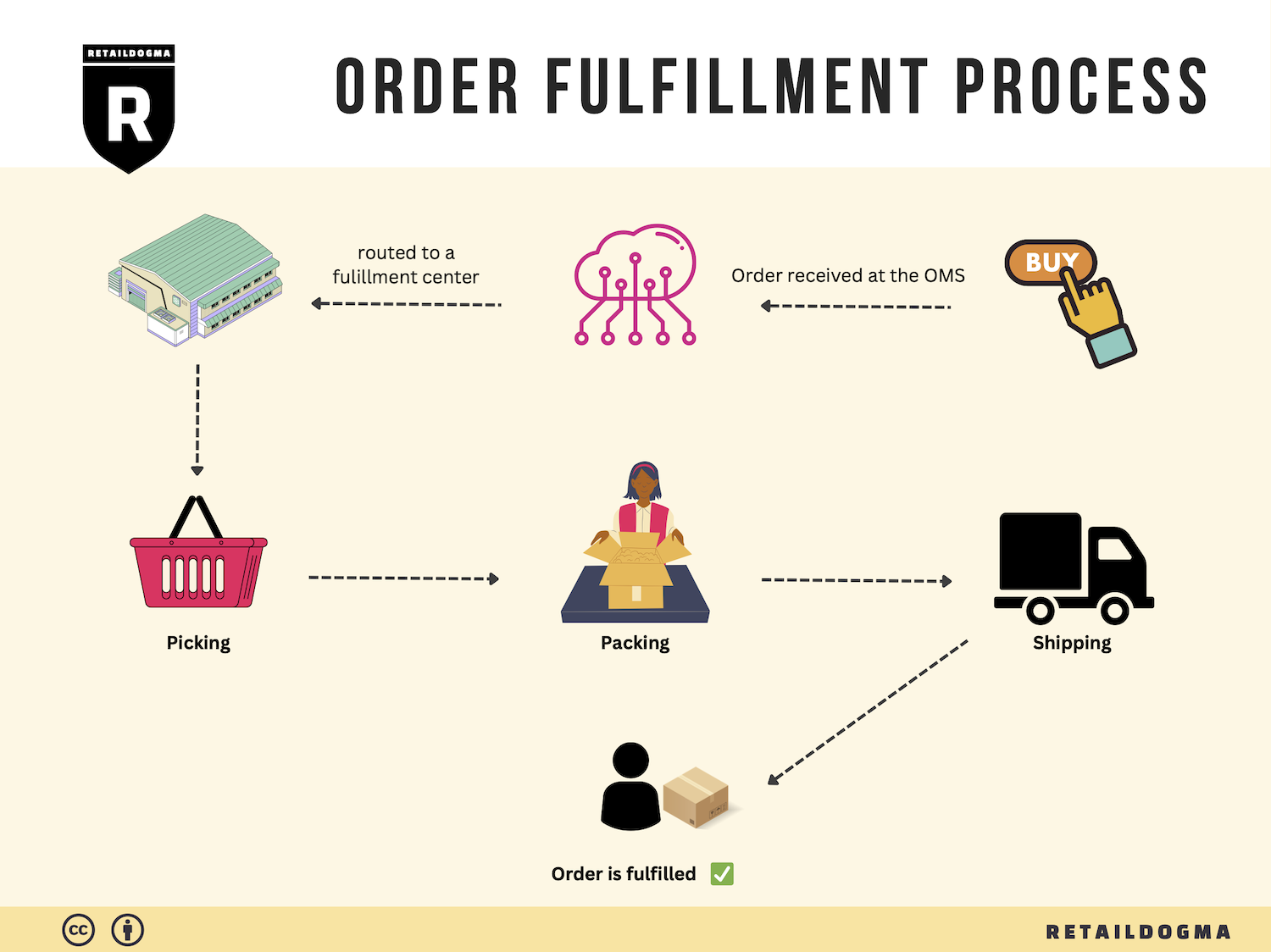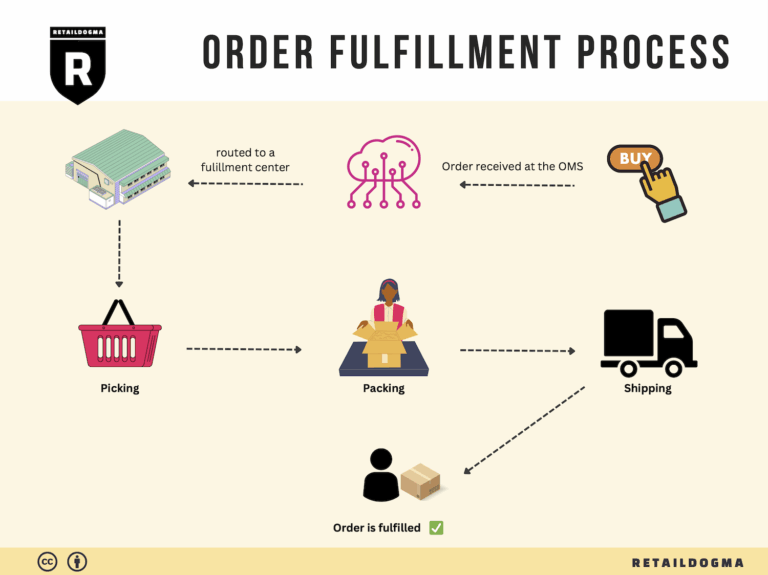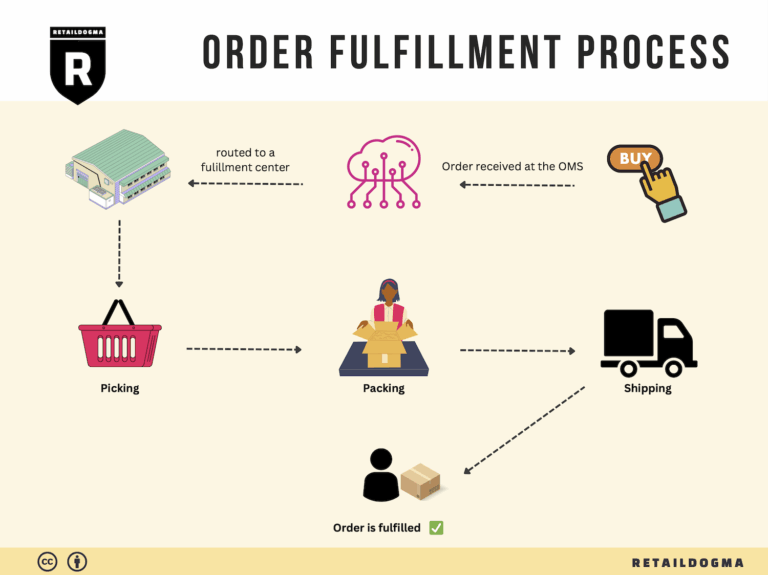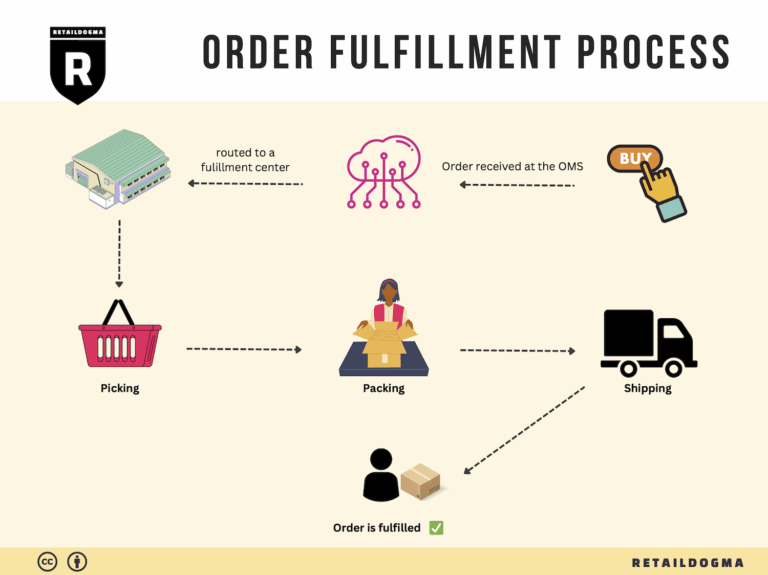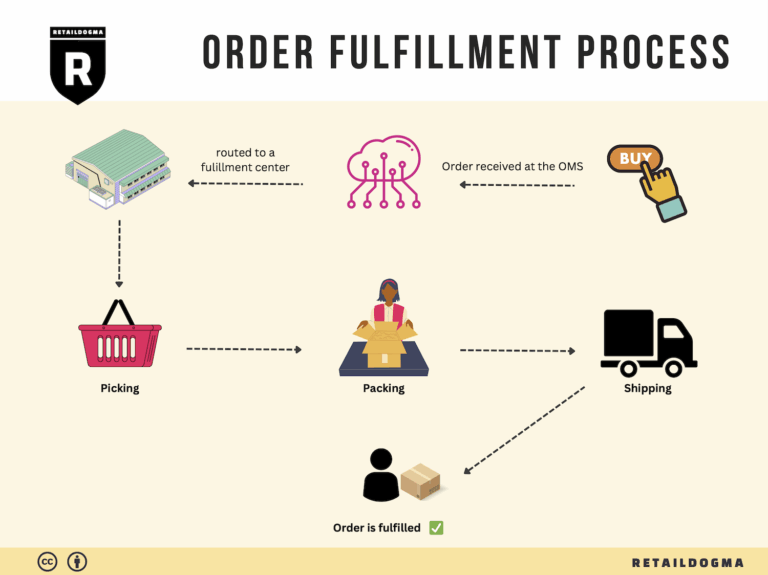What Is A Fulfillment Center? A Complete Guide (2025)
What is E-commerce Fulfillment? An Introduction for Growing Businesses
Navigating the Challenges of Order Fulfillment
For many growing e-commerce businesses, the excitement of expanding sales can quickly become overshadowed by the daunting tasks of packing and shipping orders. As your customer base grows, so does the volume of orders, and with it, the complexity of logistics. This often leads to a common pain point: feeling overwhelmed by the logistical demands of fulfilling orders efficiently and accurately. It can be a significant drain on resources and can detract from focusing on core business activities such as marketing and product development.
E-commerce fulfillment encompasses the entire process of getting a product from your inventory to your customer’s doorstep. This process includes order processing, picking, packing, shipping, and handling returns. Understanding the nuances of fulfillment is crucial for any online business looking to scale effectively.
This guide aims to demystify e-commerce fulfillment by exploring various models that businesses can adopt, including Third-Party Logistics (3PL) and Fulfillment by Amazon (FBA). Each model has its own set of advantages and challenges, and we’ll break down what each entails so you can identify which might be the best fit for your business.
We will also cover the core services that fulfillment partners typically provide, such as inventory management, order tracking, and customer service. Knowing what to expect from a fulfillment partner can help you make informed decisions and ensure that you choose a provider that aligns with your operational needs and customer expectations.
Selecting the right fulfillment partner is another critical aspect we will address. Factors such as location, technology integration, scalability, and customer support can significantly impact your fulfillment efficiency. The guide will provide practical tips on how to evaluate potential partners and what questions to ask during the selection process.
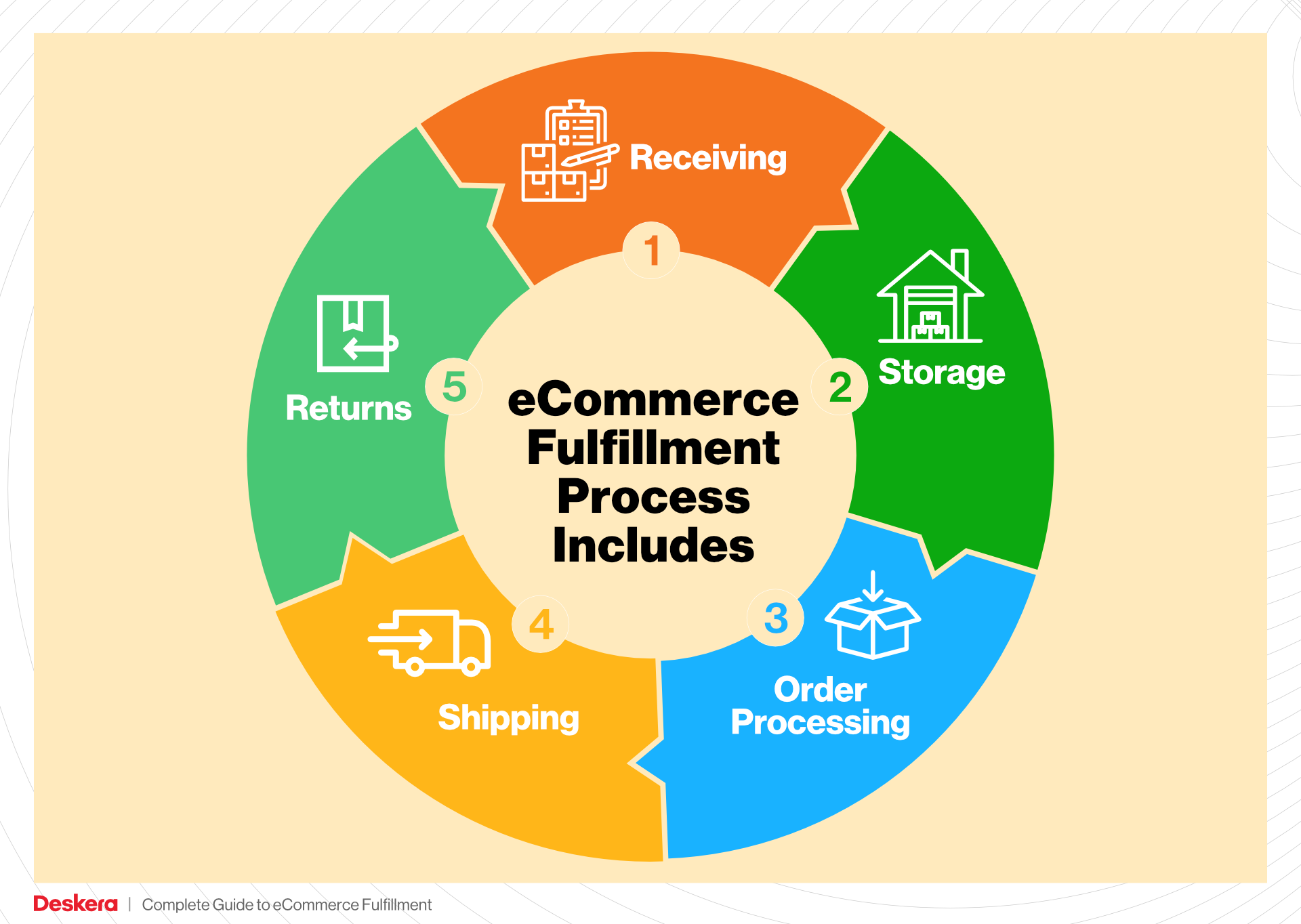
Finally, we will delve into pricing structures associated with fulfillment services. Understanding the cost implications of different fulfillment models will empower you to budget appropriately and maximize your profit margins.
By the end of this guide, our goal is to equip e-commerce business owners and operations managers with the knowledge and insights needed to make smart, strategic decisions about their logistics. Whether you are just starting or looking to refine your existing fulfillment processes, this guide will serve as a valuable resource on your journey to scaling your online business.
What You’ll Learn In This Guide
- What is E-commerce Fulfillment? An Introduction for Growing Businesses
- The Order Fulfillment Process: From ‘Buy’ Button to Customer’s Door
- Comparing Fulfillment Models: In-House vs. 3PL vs. Dropshipping
- A Deep Dive into Amazon FBA: Pros, Cons, and Who It’s For
- Core Services Offered by Fulfillment Centers
- How to Choose a Fulfillment Partner: A 6-Point Checklist
- Understanding Fulfillment Pricing: A Breakdown of Common Fees
- Frequently Asked Questions (FAQs) about Fulfillment
- Conclusion: Is Outsourcing Fulfillment the Right Move for Your Business?
- Important Disclaimer
The Order Fulfillment Process: From ‘Buy’ Button to Customer’s Door
1. Receiving Inventory
The order fulfillment process begins with the receiving of inventory at the fulfillment center. This step involves the acceptance of goods from suppliers, which are then checked for quality and quantity against purchase orders.
Importance: Efficient receiving is crucial as it sets the foundation for the entire fulfillment operation. Properly received inventory ensures that the correct products are available for order processing, which helps prevent stockouts and inaccuracies.
Key Term: SKU (Stock Keeping Unit) – Each product is assigned a unique SKU, which simplifies tracking and managing inventory levels. By using SKUs, businesses can quickly identify products, manage stock, and facilitate smoother future operations.
2. Warehouse Storage
Once the inventory has been received and verified, it is moved into the warehouse storage area. This involves organizing products in a systematic manner, often based on product type, size, or sales velocity.
Importance: Effective storage solutions are vital for maximizing space and ensuring fast retrieval of products. A well-organized warehouse reduces the time spent locating items, thus speeding up the overall order fulfillment process.
Key Term: Bin Location – A bin location is a specific area within the warehouse designated for storing particular SKUs. Properly labeled bin locations aid pickers in quickly finding products, enhancing operational efficiency.
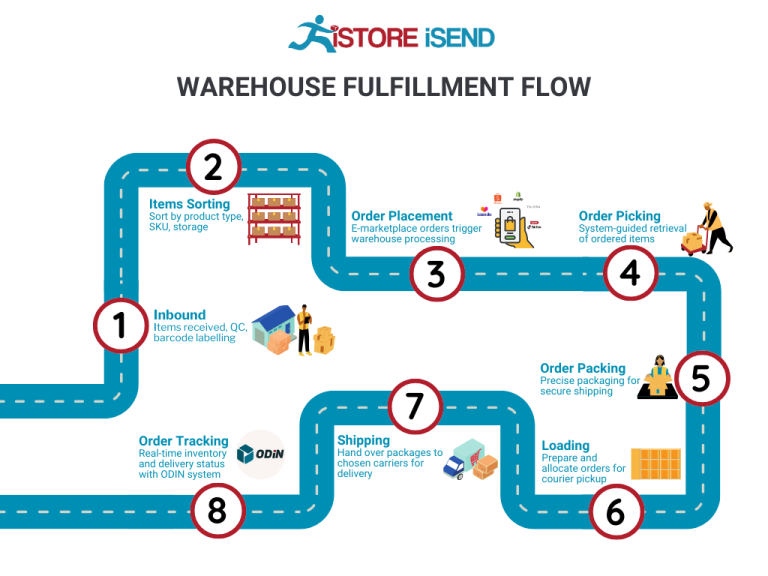
3. Order Picking
The next step in the order fulfillment process is order picking, where warehouse staff retrieve items from storage to fulfill customer orders. This process can be manual or automated, depending on the size and technology of the fulfillment center.
Importance: Efficient picking is critical for meeting customer expectations regarding order accuracy and delivery speed. Errors in picking can lead to customer dissatisfaction, increased returns, and additional costs.
Key Term: Pick List – A pick list is a document that details the items to be picked for a specific order, including quantities and bin locations. Utilizing pick lists streamlines the picking process, ensuring that the right items are collected efficiently.
4. Order Packing
After items have been picked, they move to the order packing stage. Here, products are carefully packed into boxes or envelopes, often with protective materials to prevent damage during transit.
Importance: Packing is a critical step that ensures products arrive safely at the customer’s door. Well-packed orders not only minimize damages but also enhance the unboxing experience for customers, which can lead to repeat purchases.
Key Term: Packing Slip – A packing slip is included in the package and lists the items included in the shipment. This document serves both as a confirmation of what was sent and as a reference for the customer, helping to facilitate returns if necessary.
5. Shipping & Delivery
The final step in the order fulfillment process is shipping and delivery. Once packed, orders are labeled and prepared for shipment. This may involve transferring the packages to shipping carriers such as UPS, FedEx, or USPS.
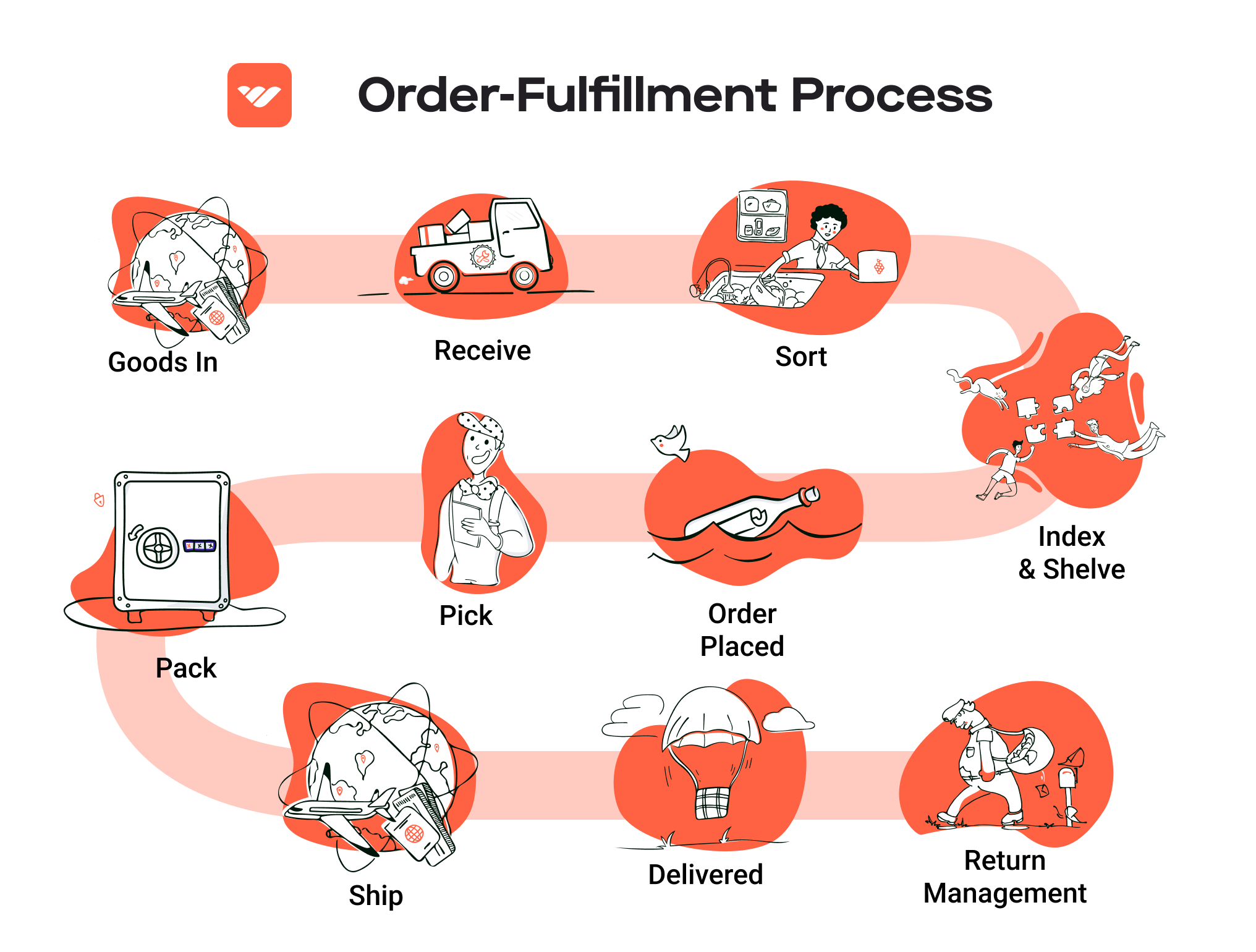
Importance: Timely shipping is crucial for customer satisfaction, especially in the age of fast delivery expectations. Efficient shipping operations can significantly influence a business’s reputation and customer loyalty.
Key Term: Last-Mile Delivery – This term refers to the final step of the delivery process, where the package is transported from a distribution center to the customer’s doorstep. Optimizing last-mile delivery is essential for ensuring that customers receive their orders quickly and efficiently, which is increasingly becoming a competitive differentiator in e-commerce.
By understanding and optimizing each of these five steps in the order fulfillment process, e-commerce businesses can enhance their operational efficiency, improve customer satisfaction, and ultimately scale their logistics to meet growing demand.
Comparing Fulfillment Models: In-House vs. 3PL vs. Dropshipping
Fulfillment Model Comparison
| Model | Who Handles Inventory | Best For (Business Stage) | Key Advantage | Key Disadvantage |
|---|---|---|---|---|
| In-House Fulfillment | Business owner/team | Established businesses with stable sales | Full control over inventory and operations | High overhead costs and resource-intensive |
| Third-Party Logistics (3PL) | 3PL provider | Growing businesses looking to scale | Cost-effective and scalable solutions | Less control over inventory and fulfillment speed |
| Dropshipping | Supplier/Manufacturer | Startups and businesses testing markets | Low startup costs and no inventory risk | Lower profit margins and reliance on suppliers |
In-House Fulfillment
In-house fulfillment refers to the process where businesses manage their own inventory and logistics operations. This model allows companies to maintain complete control over their inventory, order processing, and shipping methods. Typically, established businesses with stable sales adopt this model, as it requires significant resources, including warehousing space, staff, and technology.
The key advantage of in-house fulfillment is the level of control it provides. Businesses can oversee every aspect of the fulfillment process, ensuring that quality standards are met and that orders are shipped promptly. Additionally, having direct access to inventory means that companies can quickly adapt to changes in demand or adjust their inventory levels as needed. However, the main disadvantage is the high overhead costs associated with staffing, warehousing, and maintaining fulfillment technology. This can strain financial resources, particularly for small to medium-sized enterprises that are still trying to establish their market presence.
Third-Party Logistics (3PL)
Third-party logistics (3PL) is a model in which a business outsources its fulfillment operations to a specialized logistics provider. This model is ideal for growing businesses looking to scale their operations without the burden of managing logistics themselves. 3PL providers typically handle everything from inventory storage to order processing and shipping, allowing businesses to focus on their core competencies, such as marketing and product development.
One of the key advantages of using a 3PL is cost-effectiveness. By outsourcing fulfillment, businesses can benefit from the economies of scale that 3PLs offer, reducing the overall costs associated with warehousing and shipping. Additionally, 3PLs often have advanced technology and systems in place to optimize the fulfillment process, which can enhance efficiency. However, a notable disadvantage is the loss of control over inventory and fulfillment speed. Businesses may experience delays or inaccuracies if the 3PL does not meet their expectations, which can negatively impact customer satisfaction and brand reputation.
Dropshipping
Dropshipping is a fulfillment model where the business sells products without holding inventory. Instead, when a customer places an order, the retailer purchases the item from a third-party supplier who then ships it directly to the customer. This model is particularly attractive for startups and businesses that are still testing their market, as it requires minimal upfront investment and eliminates the risk associated with inventory management.
The primary advantage of dropshipping is the low startup costs. Entrepreneurs can launch an e-commerce store without the need to invest in inventory upfront, allowing them to experiment with different products and markets. This flexibility is particularly appealing for businesses looking to test new ideas or niches without significant financial commitment. However, the key disadvantage of dropshipping is the lower profit margins. Since retailers rely on third-party suppliers for fulfillment, they often face competition from other retailers selling the same products, leading to price wars that can erode profit margins. Additionally, businesses are dependent on suppliers for product quality and shipping times, which can lead to customer dissatisfaction if not managed carefully.
In conclusion, choosing the right fulfillment model depends on a variety of factors including business size, growth stage, and operational capabilities. Each model presents unique advantages and disadvantages, and understanding these can help e-commerce businesses make informed decisions as they scale their operations.
A Deep Dive into Amazon FBA: Pros, Cons, and Who It’s For
Understanding Fulfillment by Amazon (FBA)
Fulfillment by Amazon (FBA) is a service that allows sellers to store their products in Amazon’s fulfillment centers, where Amazon takes care of storage, packaging, and shipping. This model leverages Amazon’s extensive logistics network, enabling sellers to benefit from Amazon’s reputation and infrastructure. When a customer orders a product, Amazon handles the entire process—from picking the item from the shelf to packing it and shipping it to the customer. This service not only simplifies logistics for sellers but also enhances the customer experience through fast and reliable shipping options.
The process begins when a seller creates an Amazon seller account and sets up FBA. They send their products to an Amazon fulfillment center, such as the one located at 172 Trade St, Lexington, KY (LEX2). Once the products are stored, they become eligible for Amazon Prime, meaning Prime members can receive their orders within two days. This eligibility can significantly increase the visibility and attractiveness of products to potential buyers.
How FBA Works
-
Inventory Management: Sellers manage their inventory through the Amazon Seller Central dashboard, where they can monitor stock levels and sales data. Sellers are responsible for ensuring that their products are in stock and comply with Amazon’s guidelines.
-
Shipping to Amazon: Sellers prepare their products and ship them to Amazon fulfillment centers. Amazon provides specific guidelines on how products should be packed and labeled.
-
Order Fulfillment: When a customer places an order, Amazon picks, packs, and ships the product on behalf of the seller. They handle customer service and returns, which can be a significant time-saver for sellers.
-
Fees: Sellers pay for FBA services based on storage space and fulfillment costs. The fee structure includes monthly storage fees for the space their products occupy and fulfillment fees for each unit sold.
Pros of FBA
1. Prime Eligibility
One of the most significant advantages of using FBA is eligibility for Amazon Prime. This feature allows sellers to reach a vast audience of Prime members who prefer products that offer free two-day shipping. By being part of the Prime program, sellers can significantly increase their sales potential.
2. Customer Trust
Amazon is synonymous with reliability and customer satisfaction. By utilizing FBA, sellers benefit from Amazon’s established brand trust, as customers are more likely to purchase products fulfilled by Amazon due to the perceived quality of service.
3. Multi-Channel Fulfillment
FBA is not limited to sales on Amazon. Sellers can also use FBA to fulfill orders from other sales channels, such as their own website or eBay. This multi-channel fulfillment capability allows businesses to streamline their logistics while maintaining a consistent customer experience across platforms.
4. Simplified Logistics
FBA simplifies the logistics of selling online. Sellers do not need to manage their own warehousing, packing, or shipping processes. This can be particularly beneficial for small businesses or entrepreneurs who may lack the resources to handle logistics efficiently.
5. Comprehensive Customer Service
Amazon handles customer inquiries and returns, relieving sellers of these responsibilities. This support can enhance the overall customer experience and allow sellers to focus on growing their business.
Cons of FBA
1. High Fees
While FBA offers many advantages, the fees associated with the service can be a drawback. Sellers must pay for storage, fulfillment, and additional services, which can add up and significantly impact profit margins, especially for low-cost items.
2. Strict Inventory Rules
Amazon has stringent inventory management policies that sellers must adhere to. These include restrictions on the types of products that can be sold and the quantity of inventory stored. Failure to comply with these rules can result in penalties or account suspension.
3. Commingling Risks
FBA employs a commingling strategy where inventory from different sellers may be stored together. This can lead to issues where sellers may receive negative feedback for products they did not sell or for damaged items. Sellers must be vigilant in managing their brand reputation.
4. Limited Control Over Shipping
Sellers have limited control over the shipping process, including shipping speed and packaging. While Amazon strives for a consistent level of service, issues can arise that affect a seller’s brand image.
5. Dependency on Amazon
Using FBA means relying heavily on Amazon’s platform and policies. Any changes in Amazon’s algorithms, fees, or policies can directly impact a seller’s business.
Who is FBA Best For?
FBA is an excellent choice for various types of sellers, particularly:
-
Small to Medium-Sized Businesses: Companies that may not have the resources to manage their own warehousing and logistics can benefit from Amazon’s infrastructure.
-
E-commerce Entrepreneurs: New sellers looking to establish a presence on Amazon can take advantage of FBA’s customer trust and logistical capabilities to grow their sales quickly.
-
Brands with High Inventory Turnover: Sellers with products that have a high sales volume can maximize their profits by leveraging FBA’s speed and efficiency.
-
Multi-Channel Sellers: Businesses that sell on multiple platforms can streamline their fulfillment processes through FBA, ensuring a consistent customer experience across all channels.
In conclusion, FBA can be a powerful tool for e-commerce businesses looking to scale. While it offers numerous benefits, it is crucial for sellers to weigh the costs and potential drawbacks to determine if it aligns with their business strategy. Careful planning and management can help sellers navigate the complexities of FBA while maximizing their growth potential.
Core Services Offered by Fulfillment Centers
Inventory Management & Warehousing
Inventory management and warehousing are foundational services provided by fulfillment centers that directly impact an e-commerce business’s operational efficiency. This service involves the systematic control of inventory levels, ensuring that products are stored securely and are readily available for order fulfillment.
The fulfillment center utilizes sophisticated inventory management systems that track stock levels, product locations, and order statuses in real-time. This technology allows businesses to maintain optimal inventory levels, reducing the risk of overstocking or stockouts, which can lead to lost sales and customer dissatisfaction.
For e-commerce businesses, efficient inventory management means improved cash flow and reduced holding costs. By outsourcing warehousing to a fulfillment center, businesses can scale their operations without the burden of managing a physical storage space, allowing them to focus on core activities such as marketing and product development. Additionally, enhanced visibility into inventory data aids in making informed purchasing decisions, ultimately driving profitability.
Pick and Pack Services
Pick and pack services are another critical offering from fulfillment centers. This process involves selecting the right products from the warehouse (picking) and packaging them for shipment (packing). Fulfillment centers employ streamlined procedures to ensure that orders are processed quickly and accurately, often utilizing automation and technology to enhance speed and efficiency.
The benefits of efficient pick and pack services for e-commerce businesses are manifold. Firstly, they significantly reduce order processing times, which is essential for meeting customer expectations, especially with the growing demand for fast shipping options like Amazon Prime. By ensuring that orders are picked and packed accurately, fulfillment centers minimize the risk of shipping errors that can lead to costly returns and customer dissatisfaction.
Moreover, outsourcing pick and pack services allows businesses to leverage the expertise of fulfillment centers, which often employ trained staff and advanced systems to handle high order volumes. This not only enhances operational efficiency but also provides scalability, enabling businesses to grow without the headaches associated with managing order fulfillment in-house.
Kitting and Assembly
Kitting and assembly services refer to the process of bundling various products together to create a single SKU or preparing components for a final product. This can include assembling gift sets, promotional kits, or complex items that require multiple components. Fulfillment centers offer these services to help e-commerce businesses streamline their operations and enhance their product offerings.
The primary advantage of kitting and assembly is that it allows businesses to create unique product offerings that cater to specific customer needs or seasonal demands. By providing ready-to-ship kits, businesses can reduce handling time during the order fulfillment process, as these kits can be picked and packed as single units.
Furthermore, kitting can lead to increased sales through the promotion of bundled products at a discounted price, encouraging customers to purchase more items. It also simplifies inventory management, as businesses can track fewer SKUs while still offering a wide variety of products. This added flexibility can be a significant competitive advantage in a crowded market.
Returns Management (Reverse Logistics)
Returns management, often referred to as reverse logistics, is a vital service provided by fulfillment centers that addresses the complexities of handling product returns. This process involves receiving returned items, inspecting them, restocking them, or processing them for disposal or refurbishment as necessary.
For e-commerce businesses, an efficient returns management system is crucial for maintaining customer satisfaction and loyalty. A streamlined returns process can turn a potentially negative experience into a positive one, encouraging customers to shop again. Fulfillment centers typically have established procedures to handle returns quickly, ensuring that customers receive refunds or exchanges without unnecessary delays.
Additionally, effective returns management allows businesses to analyze return reasons, providing valuable insights into product quality and customer preferences. This data can inform future product development and inventory decisions, ultimately leading to improved customer experience and reduced return rates. In a landscape where customer expectations for hassle-free returns are high, leveraging a fulfillment center’s expertise in reverse logistics can significantly enhance a brand’s reputation and customer retention.
By utilizing these core services offered by fulfillment centers, e-commerce businesses can optimize their operations, improve customer satisfaction, and scale efficiently in a competitive marketplace.
How to Choose a Fulfillment Partner: A 6-Point Checklist
Location & Warehouse Network
Why It’s Important:
The geographical location of your fulfillment partner’s warehouses directly affects shipping times and costs. A partner with strategically placed facilities can reduce transit times and improve customer satisfaction, especially if your target market is concentrated in specific regions.
Questions to Ask:
– Where are your fulfillment centers located, and how do those locations align with my primary customer base?
– Can you provide insights into your logistics network and how you optimize shipping routes?
– What is your average shipping time to key regions?
– Do you have plans to expand your warehouse network in the near future?
Technology & Integrations
Why It’s Important:
In today’s fast-paced e-commerce environment, technology plays a crucial role in inventory management, order processing, and customer communication. A fulfillment partner that offers robust technology and seamless integrations can streamline operations and provide real-time visibility into inventory and shipments.
Questions to Ask:
– What inventory management systems do you use, and how do they integrate with my existing platforms (e.g., Shopify, Amazon, etc.)?
– Do you offer real-time tracking for orders, and how can I access this information?
– How do you handle data security, especially regarding customer information?
– Can your technology scale as my business grows?
Specializations (e.g., cold storage, oversized items)
Why It’s Important:
Not all fulfillment centers are equipped to handle every type of product. If your business involves specialized items such as perishables or oversized goods, it’s crucial to partner with a provider that has the necessary capabilities and expertise.
Questions to Ask:
– What specific types of products do you specialize in fulfilling?
– Do you have facilities that cater to special requirements like temperature control or oversized items?
– Can you handle unique packaging or labeling needs?
– What experience do you have with products in my category?
Scalability & Capacity
Why It’s Important:
As your business grows, your fulfillment needs will change. Choosing a partner that can easily scale with you is essential to avoid disruptions in service or delays in order fulfillment.
Questions to Ask:
– How do you handle fluctuations in order volume during peak seasons?
– What are your current capacity limits, and how quickly can you scale up if needed?
– Are there any additional fees associated with scaling my operations?
– How do you manage inventory during periods of rapid growth?
Pricing and Contracts
Why It’s Important:
Understanding the pricing structure and contract terms is vital to ensure that your fulfillment partner aligns with your budget and business model. Hidden fees can quickly erode profit margins, so clarity upfront is essential.
Questions to Ask:
– Can you provide a detailed breakdown of your pricing model, including storage, shipping, and handling fees?
– Are there any additional costs for services such as returns, packaging, or special handling?
– What are the contract terms, and is there flexibility to adjust as my needs change?
– Can you provide a trial period to evaluate your services without a long-term commitment?
Customer Support & Reviews
Why It’s Important:
Reliable customer support can make a significant difference in your partnership. A fulfillment partner with excellent customer service can help resolve issues quickly, ensuring that your operations run smoothly.
Questions to Ask:
– What are your customer support hours, and how can I reach your support team (phone, email, chat)?
– Do you have a dedicated account manager who will oversee my account?
– Can you share testimonials or case studies from other businesses in my industry?
– How do you handle issues such as damaged goods or missed shipments, and what is your process for resolving disputes?
Conclusion
Choosing the right fulfillment partner is critical for the success of your e-commerce business. By evaluating potential partners based on these six key criteria, you can ensure that you select a fulfillment service that aligns with your operational needs and growth ambitions. Taking the time to ask the right questions and thoroughly assess each partner will help you make an informed decision that supports your business’s long-term success.
Understanding Fulfillment Pricing: A Breakdown of Common Fees
Initial Setup Fees
When you start using an Amazon Fulfillment Center, such as LEX2 in Lexington, KY, the first cost you may encounter is the initial setup fee. This fee typically covers the administrative costs associated with onboarding your account and integrating your inventory into the fulfillment system.
Setup fees can vary widely depending on the service provider and may include costs for account creation, integration with existing e-commerce platforms, and training on how to use the fulfillment system. Some providers might waive this fee as part of a promotional offer or if you commit to a certain volume of business. To get a clear understanding of these costs, always ask for a detailed breakdown during negotiations.
Receiving Fees
Receiving fees are charged when your inventory arrives at the fulfillment center. These fees cover the labor and resources needed to unload, inspect, and catalog your products into the warehouse system.
Typically calculated on a per-unit basis, receiving fees might be structured as a flat rate per item or vary based on the size and weight of the products. For instance, smaller items may incur a lower fee compared to bulky or heavy items. It’s essential to understand the receiving fee structure as it directly impacts your overall fulfillment costs. Accurate inventory planning can help mitigate these fees by ensuring that shipments are consolidated and optimized.
Storage Fees (per pallet/bin)
Storage fees are ongoing costs incurred for holding your inventory within the fulfillment center. These fees are typically calculated based on the volume of space your products occupy, usually measured in pallets or bins.
Amazon often charges storage fees on a monthly basis, with separate rates for standard-size items and oversized items. During peak seasons, such as the holiday shopping period, these fees may increase due to higher demand for storage space. To manage storage costs effectively, regularly review your inventory turnover rates and consider using tools for inventory forecasting. This can help you minimize excess stock and associated storage fees.
Pick & Pack Fees (per item/order)
Pick & pack fees are charged each time an item is picked from inventory and packed for shipping. This fee usually includes the labor involved in locating the item, assembling the order, and preparing it for shipment.
The fee structure can vary depending on the number of items in an order. For example, there may be a base fee for the first item and an additional charge for each subsequent item. Understanding how these fees are structured is crucial for managing your shipping costs, particularly if you offer multi-item discounts to your customers. Streamlining your product offerings can help reduce pick & pack fees by minimizing complexity in order fulfillment.
Shipping Fees
Shipping fees cover the cost of delivering your products to customers and are generally determined by several factors, including the destination, weight of the package, and selected shipping speed.
Amazon typically offers various shipping options, ranging from standard to expedited shipping, each with its own pricing. Additionally, if you use Amazon’s Fulfillment by Amazon (FBA) service, these fees might be bundled with other fulfillment costs, making it easier to estimate total shipping expenses. When calculating shipping fees, it’s beneficial to analyze your customer base’s shipping preferences and adjust your pricing strategy accordingly to remain competitive.
Tips for Getting an Accurate Quote
-
Request Detailed Estimates: Always ask for a comprehensive quote that breaks down each fee category. This helps in understanding the cost structure and enables better budgeting.
-
Consider Volume Discounts: Many fulfillment centers offer tiered pricing based on volume. If you anticipate significant sales, inquire about potential discounts that could reduce your overall costs.
-
Review Service Level Agreements (SLAs): Ensure that you understand the service levels provided, including order processing times and shipping guarantees, as these can influence costs.
-
Monitor Your Inventory: Regularly assess your inventory levels and turnover rates to avoid unnecessary storage fees and optimize receiving costs.
-
Negotiate Terms: Don’t hesitate to negotiate terms with your fulfillment provider. Building a long-term partnership can lead to favorable pricing adjustments.
By understanding these common fulfillment pricing models and actively managing your logistics strategy, you can optimize your operations and enhance your e-commerce profitability.
Frequently Asked Questions (FAQs) about Fulfillment
1. What is the Amazon Fulfillment Center LEX2?
The Amazon Fulfillment Center LEX2, located at 172 Trade St, Lexington, KY, is part of Amazon’s extensive network of fulfillment centers. It specializes in storing and processing orders for a wide range of products, including medical supplies, household goods, and luxury items. This facility is designed to ensure efficient order fulfillment, leveraging Amazon’s advanced logistics and technology to provide quick shipping options, including Prime delivery.
2. How does the fulfillment process work at LEX2?
At LEX2, the fulfillment process begins when products are received and stored in the warehouse. When an order is placed, the items are picked, packed, and prepared for shipment. Depending on the destination, packages may be sent directly to carriers like UPS, FedEx, or USPS, or transferred to a sortation center for further sorting before delivery. This streamlined process helps ensure that customers receive their orders promptly.
3. What delivery options are available through Amazon Fulfillment Center LEX2?
Amazon Fulfillment Center LEX2 offers multiple delivery options, including standard shipping, two-day Prime shipping, and same-day delivery for eligible items. Customers can choose their preferred delivery method at checkout, allowing for flexibility based on urgency and shipping costs.
4. What is the difference between a warehouse and a fulfillment center?
A warehouse is primarily a storage facility where goods are kept until they are needed. In contrast, a fulfillment center not only stores products but also processes orders, picks, packs, and ships them directly to customers. Fulfillment centers are equipped with technology and staff to manage the entire order lifecycle, making them crucial for e-commerce operations.
5. What is a 3PL (Third-Party Logistics) provider?
A 3PL provider is a company that offers outsourced logistics services to businesses. This can include warehousing, fulfillment, inventory management, and transportation. By partnering with a 3PL, businesses can leverage the provider’s expertise and infrastructure, allowing them to scale operations without the need for significant capital investment in logistics.
6. How much do fulfillment services cost at Amazon Fulfillment Center LEX2?
The cost of fulfillment services at Amazon varies based on several factors, including the size and weight of the items, the volume of orders, and the specific services required (such as storage fees and shipping costs). Generally, businesses can expect to pay a per-item fee for fulfillment services, along with additional costs for storage and special handling.
7. How can businesses benefit from using Amazon Fulfillment Center LEX2?
Businesses can benefit from using LEX2 by gaining access to Amazon’s vast logistics network, which ensures fast and reliable shipping. This can enhance customer satisfaction and retention. Additionally, businesses can leverage Amazon’s technology and customer service capabilities, allowing them to focus on other core aspects of their operations while reducing the burden of order fulfillment.
8. What types of products can be stored at LEX2?
Amazon Fulfillment Center LEX2 can store a wide variety of products, including medical supplies, household items, baby care products, electronics, and luxury goods. However, there are restrictions on certain categories, such as hazardous materials or perishables. Businesses should review Amazon’s guidelines for restricted products before sending inventory.
9. How does Amazon ensure data security and privacy at LEX2?
Amazon prioritizes data security and privacy by implementing robust security measures, including encryption, access controls, and regular audits. The company adheres to strict compliance standards to protect customer data and ensure a secure shopping environment. Businesses utilizing LEX2 can rest assured that their information, as well as their customers’, is safeguarded.
10. Can businesses track their inventory and orders at LEX2?
Yes, businesses can track their inventory and orders using Amazon’s Seller Central platform. This tool provides real-time visibility into inventory levels, order statuses, and shipping information. By leveraging these insights, businesses can better manage their stock and optimize their fulfillment strategies to meet customer demand effectively.
Conclusion: Is Outsourcing Fulfillment the Right Move for Your Business?
Evaluating the Benefits of Outsourcing Fulfillment
Outsourcing fulfillment can be a transformative strategy for e-commerce businesses aiming to scale efficiently. By leveraging a fulfillment service, companies can save significant time and resources. Instead of managing inventory, packing, and shipping, business owners can focus on core activities such as product development, marketing, and customer engagement. This shift allows for a more strategic allocation of time and resources, fostering innovation and growth.
Moreover, fulfillment services offer scalability that is often unattainable with in-house operations. As your business grows, so do your logistics demands. A reliable fulfillment partner can adapt to fluctuating order volumes, ensuring that you can meet customer expectations without compromising on service quality. This flexibility is essential in today’s dynamic market, where consumer preferences and demands can change rapidly.
Additionally, partnering with a fulfillment service provides access to industry expertise and advanced technology. Many fulfillment centers, such as the Amazon Fulfillment Center in Lexington, KY, boast sophisticated inventory management systems and a vast network of shipping options, which can enhance delivery speed and reliability. This expertise can lead to improved customer satisfaction, as well as reduced operational risks and costs.
However, the importance of selecting the right fulfillment partner cannot be overstated. A misalignment in values, capabilities, or service standards can hinder your growth rather than support it. Conduct thorough due diligence, assessing potential partners on criteria such as their track record, customer service, and technology capabilities.
Call to Action
As you consider the potential of outsourcing your fulfillment operations, take the time to audit your current shipping process. Analyze your pain points and growth aspirations to determine if a fulfillment partner could be the next strategic step for your business. Investing in the right partnership can pave the way for sustainable growth and increased competitiveness in the e-commerce landscape.
Important Disclaimer
⚠️ Important Disclaimer
The information in this guide is for educational purposes. Fulfillment services, pricing, and platform features change frequently. Always conduct your own due diligence and consult with providers directly before making business decisions.
